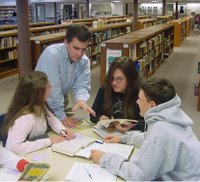Still shifting, trying to keep pace
Karl Fisch knows something about informative videos that provoke thought about Web 2.0 applications and their impact on the changing educational landscape. Here is one he came across at a digital ethnography workshop. The video, created by Michael Wesch of Kansas State University, explores the changing nature of text, from a linear, pre-digital view, to one showcasing the vast capabilities of hyper and digital text, which is forcing a shift in the way we think about and use the Internet. In other words, it details what Web 2.0 is.
For me, videos like this are helping me wrap my brain around exactly what is happening in our digital world and what it means for my students inside my classroom. What's especially enticing to me is that these Web 2.0 innovations are forcing us to rethink the relationship between one another, between ideas. Folks like Karl and Will Richardson and Wesley Fryer are far ahead of the curve. Here's where I stand. In the last three months, I have been introduced to Web 2.0, unlike many of my colleagues. It's moving now from outside observer to novice user and apprentice. The journey has begun. My students, too, are forced to go along for the ride, first when we began posting homework on the blog to my Literature Circles wiki project. What's next? If I truly want to embed these concepts of flat world collaboration and information sharing in the curriculum, I need to rethink my approach to the content in the class. A similar shift happened a few years back when I began experimenting with a more integrated Literature Circles approach in the classroom, which essentially required that I cede some control of what happens - what to read, what to focus on in discussions, what to write about - to the students. It still needs to happen. In today's classrooms, we can no longer have a stubbornly defined image of what we require students to create. I'm not just talking big picture either, but rather what we expect daily or weekly or monthly. How else can we teach students to be ready to embrace and question what the future will mean to their world if we don't model that same approach in our classrooms?
The students are easy. It's our colleagues that pose a bigger challenge. The first thing I think I'll do is show them that video.






No comments:
Post a Comment